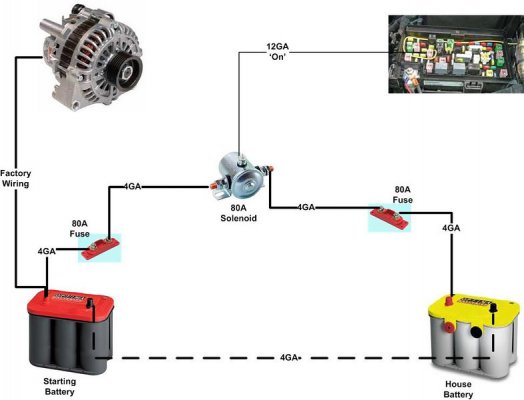xxaarraa
Full Access Member
Hey guys,
Need some thoughts from guys who have dual battery / big inverter setups installed in their trucks.
Here is the use case: I want to be able to run a Keurig or a small microwave while overlanding, for short periods, powered by the truck.
Here is the solution we are thinking of:
- Add an identical second battery in parallel to the stock battery. We are thinking we need a second battery since a Keurig or small microwave will likely pull a lot of amps at startup, and so a single battery will not have enough juice for startup even with truck running.
- Run zero gauge wiring from it to bed, and install a 2000W inverter in the bed.
Pros to this setup:
- Easy to install,
- Relatively inexpensive option as it has no switches or solenoids.
Cons:
- Yes, there is no run-down protection and stock battery is at risk of getting drained and truck may not start if the accessories we are running off the second battery are left on for long periods. I don't plan on running a fridge or leaving any accessories connected, I only need the inverter to work while truck is running.
Questions:
- Stock alternator is beefy enough to keep two batteries charged, correct? I am not concerned about how long it takes to charge as I won't be drawing any power from the second battery while stationary.
- Will wiring in a second battery in line with the stock battery confuse the electrical system in any way, and throw codes etc. ?
What do you guys think? Interested in thoughts from folks with personal experience with dual battery setups.
Need some thoughts from guys who have dual battery / big inverter setups installed in their trucks.
Here is the use case: I want to be able to run a Keurig or a small microwave while overlanding, for short periods, powered by the truck.
Here is the solution we are thinking of:
- Add an identical second battery in parallel to the stock battery. We are thinking we need a second battery since a Keurig or small microwave will likely pull a lot of amps at startup, and so a single battery will not have enough juice for startup even with truck running.
- Run zero gauge wiring from it to bed, and install a 2000W inverter in the bed.
Pros to this setup:
- Easy to install,
- Relatively inexpensive option as it has no switches or solenoids.
Cons:
- Yes, there is no run-down protection and stock battery is at risk of getting drained and truck may not start if the accessories we are running off the second battery are left on for long periods. I don't plan on running a fridge or leaving any accessories connected, I only need the inverter to work while truck is running.
Questions:
- Stock alternator is beefy enough to keep two batteries charged, correct? I am not concerned about how long it takes to charge as I won't be drawing any power from the second battery while stationary.
- Will wiring in a second battery in line with the stock battery confuse the electrical system in any way, and throw codes etc. ?
What do you guys think? Interested in thoughts from folks with personal experience with dual battery setups.
Last edited:



